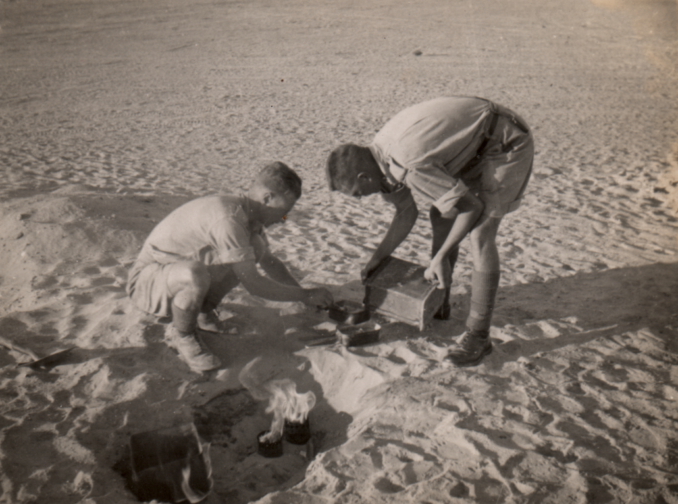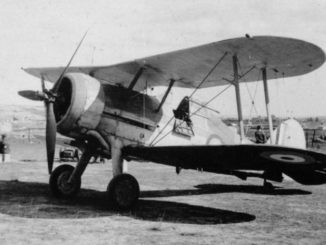
Previously unpublished photo courtesy of DJM’s uncle David, © 2021
April was a very busy month 80 years ago, Libya, Greece, Iraq and East Africa were all full of action.
On the 1st, just as Rommel began his attack, there was a coup d’état in Iraq and the pro British monarch was ousted in favour of nationalist Arabs. Much of the oil for the British efforts came from Iraq so not only was Wavell facing an attack in Libya, he also had to quell a revolt in Iraq. Next to Iraq was Vichy controlled Syria. Thousand of Indian and other troops were diverted to Iraq to stop the rebellion.
Let’s start with Libya where the German Africa Korps was starting to make a difference. On the 2nd German troops captured Agedabia and Zuetania on their way to Benghazi. On the 3rd Axis troops marched towards Benghazi which British troops evacuated under General Neame’s orders. Had we not sent forces to Greece maybe we could have put on a better show but we will never know the answer to that one. Churchill recommended Richard O’Connor as the new British commander in Libya but O’Connor turned it down and HMS Argus and Ark Royal launched 12 Hurricanes and 3 Skuas for duty in Malta. On the 4th the Axis captured Benghazi and pushed further east where they were held up by the Australian 9th Division, at the same time further south, the German 5th Light Division was also held up but by waiting for fuel. The British failed to realise this and continued falling back. On the 6th British and Australian troops left Barce and Derna heading back towards Tobruk while the advancing Germans captured Musa. By 5pm they laid siege to Mechili so after sundown Generals Neame and O’Connor moved further east towards Tmimi on the way to Tobruk.
On the 7th before daybreak, a patrol with both British Generals in it got lost and was captured by a German patrol near Derna, later that day the Germans occupied Derna. 50 miles south British, Australian and Indian troops dug in at Mechili which had been surrounded by the Germans. Sandstorms saved them for short while but Rommel ordered an attack the next day whatever the weather. On the 8th the Germans duly captured Mechili and Major General Laverack was appointed military Governor of Cyrenaica after General Neame’s demise the previous day. On the 9th the Italian 27th Division and the German 5th Light Division reached Tobruk and so began what became known as the Siege of Tobruk which lasted for 241 days and has been made into several films. On the 10th the German 15th Panzer Division attacked Tobruk from the west, one of the Generals leading it, Heinrich von Prittwitz was killed and the attack failed.
On the 11th Rommel cut the road east of Bardia but all attacks on the town itself were unsuccessful. 4 British destroyers arrived in Malta to act as a night strike force. On the 12th the Germans captured Bardia, Tobruk was now an island in a sea of erics who again attacked Tobruk without success,. On the 13th the Axis bombarded Tobruk for 30 minutes at 5pm after which one German and two Italian Divisions attacked but the Aussies fought them off. Near the Libya/Egypt border the Germans captured Fort Capuzzo which had figured in the very early days of this campaign.
The 14th was a really busy day. Two British warships bombarded German troops at Bardia in Libya and Sollum in Egypt. The ever fickle King Faroukh invited Adolf Hitler for a discussion on independence from Britain. At Tobruk German Infantry filled in anti-tank ditches and cut wires overnight so that at 5:20am 36 tanks of the 5th Panzer Regiment could go through the gap and attack. They were halted by artillery and dug in Crusader tanks 2 miles later losing 16 tanks and 400 men in the process. 40 Stukas also attacked Tobruk Harbour. Corporal John Edmundson of the 2/17th Battalion of the Australian 9th Division led a bayonet charge in this action despite being shot in the stomach and neck for which he was awarded a VC.
On the 16th it was the Italians’ turn to have a pop at Tobruk whose excellent defences had been built by the Italians. The 62nd Regiment attacked late afternoon, personally observed by Rommel. The attack was driven back by heavy artillery fire and the entire 1st Battalion of the 62nd was taken prisoner, 775 men and 25 officers, this may not have impressed Rommel but then again, the German troops couldn’t take it either. That evening 4 British destroyers aided by Ultra intercepts ambushed an Axis convoy off the Tunisian coast. 4 German troop ships, 1 Italian ammunition ship and 3 Italian destroyers were sunk. HMS Mohawk was hit by torpedos and was scuttled leaving secret documents onboard outlining the defences of the port at Alexandria. Italian divers retrieved them shortly afterwards. On the 17th the Italians again attacked Tobruk in early afternoon but were pushed back and after dark 12 Axis tanks fought with Allied tanks and 3 Axis tanks were destroyed. Yet another Italian sailing ship was captured, a barque carrying ammunition and fuel to Derna.
The situation in North Africa had been turned round by the German presence. Aside from Tobruk, by the end of April just about all of Libya was back in Axis hands and they even had a toehold in Egypt.
In Greece it was all go, on the 5th all British, Australian and NZ forces were now called the 1st Australian Corps under General Blarney, the following day German, Italian and Hungarian forces invaded Yugoslavia from Austria, Romania, Bulgaria and Albania; these same countries also invaded Greece from Bulgaria. In Piraeus a lucky bomb from the Luftwaffe hit an ammunition ship causing 11 other ships to sink. By the 6th the German 2nd Panzer Division had reached 10 miles short of the Greek border. In short while the Germans were still finishing off Yugoslavia they were also invading Greece. On the 11th the 1st Australian Corps had its first contact with the Germans. on the 14th the Yugoslavs were asking for a ceasefire and on the 14th the Yugoslavs effectively surrendered but many soldiers took to the hills and became various shades of guerillas.
By the 15th Admiral Cunningham was considering a general evacuation from Greece. On the 17th Yugoslavia formally surrendered and Churchill agreed to the proposed evacuation from Greece to Crete. The Germans continued their advance in Greece, the Greek PM took his own life and General Wavell flew to Athens to meet King George II (the uncle of our Duke of Edinburgh). The King agreed the Allies could not hold Greece and agreed the evacuation to Crete.
On the 20th the Greek Epirus Army in Albania surrendered to the SS without authorisation from the Greek government. Laughably Mussolini protested requesting that the surrender must be accepted by an Italian General, what a posturing twat he was sometimes. On the 23rd King George II, Prince Paul, the Prime Minister and other important figures were evacuated to Crete by the RAF. By the 25th the Germans were approaching Athens while the evacuations continued. Adolf also issued yet another Führer Directive, this one #28 authorising the attack on Crete to be codenamed Operation Merkur (Mercury). On the 27th the the Germans took Athens even as British troops were still being evacuated from its beaches.
After more heroics from our side Allied resistance ended on the 29th when 8,000 troops, who had been acting as a rearguard, from Greece, Yugoslavia and the 1st Australian Corps surrendered. On the same day British Intelligence picked up information about the German intention to invade Crete. Most troopships at Suda Bay were moved to Alexandria to escape raids from the Luftwaffe. On the 30th General Freyberg was appointed commander of Allied forces on Crete.
In less than a month the Germans had occupied both Yugoslavia and mainland Greece, Crete was just about the only place still to fight over.
We can’t forget Italian East Africa, or what remained of it. On the 1st advancing British tanks were met by 2 police officers from Asmara, the Eritrean capital, who declared it to be yet another open city. The Indian 5th Division entered and took 5,000 Italian PoWs. On the 2nd Admiral Bonetti with his fleet in Massawa was offered surrender terms but he declined. The Italian retreat from Eritrea was cut off before Abyssinia and in Abyssinia itself the 22nd British East African Brigade reached the Awash river.
On the 3rd Admiral Bonetti’s 5 destroyers and smaller ships were detected under way and attacked from the air. All were destroyed and with British troops only an hour away from Massawa Harbour, all remaining Italian ships there were destroyed with demolition charges. On the 4th the Indian 5th Division moved to Massawa while the Indian 4th Division was moved to Libya. In Abyssinia the Italians evacuated Addis Ababa as the British 11th African Division approached. On the 6th Haile Selassie under the protection of Orde Wingate’s Gideon Force reached Debra Markos and on the same day General Cunningham’s South Africans reached Addis Ababa itself. Eventually on the 8th Admiral Bonetti and his 10,000 men in Massawa surrendered.
The Emperor’s entry into Addis Ababa was delayed because many Italian civilians were there and fears of massacres were real. Order had to be restored first. Wingate was quite a staunch supporter of the Emperor and suspected the worst from the British Government regarding Haile Selassie. However next month he would enter his capital.
On the 10th Nigerian troops left Addis Ababa on their way to Jimma and the Indian 5th Division left Massawa heading for Amara in Abyssinia. On the 21st the 1st South African Brigade captured Camboica Pass in Abyssinia taking 1,200 Italian prisoners and five days later they captured Dessie taking 4,000 prisoners. It took a while longer but there can’t have been much of Abyssinia left in Italian hands by now. The Italians had captured it, with some difficulty, in 1935 and now, 6 years later, they were losing it.
Malta received some Hurricanes and Wellingtons towards the end of April allowing for some attacks on the Axis convoys supplying Rommel in North Africa but in general, supplying the island was becoming extremely difficult.
In other news …. on the 4th a famous (in Germany) film called Ohm Krüger was released in Germany, a very anti-British effort showing how wicked the British and their Empire-building were (we even had concentration camps you know), on the same day George Patton was promoted to the rank of Major General (he had been a Brigadier General since October 2nd), on the 8th income tax was raised to 10 shillings in the pound (that is 50% in today’s measure) and the Gloster E28/39, ancestor of the Gloster Meteor, started taxiing trials, on the 8th the jet powered E28/39 made a series of short hops at Gloster’s own airfield after which it was moved to RAF Cranwell with its longer runway, on the 9th Piaggio’s P.111 made its first flight, this was an experimental high altitude plane with a pressurised cabin that was designed to fly at 40,000 feet, on the 16th the first lend-lease food shipment arrived in Britain, on the 25th FDR called Charles Lindbergh an appeaser and on the 29th a not best pleased Charles resigned from the US Army reserves, on the last day of the month Adolf reset the start date of Operation Barbarossa to 22nd June 1941 and that is exactly the day it began, the original plan had been to start in May but with the Balkans/Greece excitement they pushed it back. Many claim this is the reason the German invasion of Russia failed but I am not convinced, the Germans would have needed to at least go past the Urals to where much manufacturing had been removed and even then the Russians could keep falling back until the enemy ran out of steam. To be sure of taking Russia from its western side you need to go an awful long way as Napoleon found out.
After 10 months the North African campaign had seen the Italians attack Egypt, the British then pushed them back half way across Libya when we stopped and concentrated on Greece. The Germans then arrived and in short time pushed us back and out of Libya.
© well_chuffed 2021
The Goodnight Vienna Audio file
Audio Player



